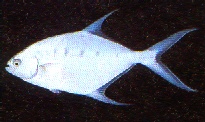
Dart, Swallowtail
(Trachinotus Coppinger)
 |
Common Names
These are the dart, Swallowtail Dart, or Sruf Trevally. It has lots of relatives, including the larger Dart (T botla) and the Blackspotted Dart (T bailloni), also the Snub-nosed Dart or Oyster-cracker.
Description
The Swallowtail Dart are from the same family as the Trevally and the Kingfish. Dart are characterised by a deep laterally-compressed body, well-forked tails and a series of larger dark blotches along the lateral line. Dart have a slender body with blue-grey on the upperbody and silver below. The fins, dorsal and anal, are often dark-tipped.
Size
Swallowtail dart are fairly small fish and most caught weigh less than 0.8 kilos. They do grow to 2.0 kilos, however I don't think may have caught one this size.
Habitat
Dart range from the mid-coast of New South Wales, right around to Pert, Western Australia. They are a tropical and sub-tropical fish, and can be found along clean beaches and around sandcays. Dart favour clean, well oxygenated, slightly turbulent waters.

Feeding
Swallowtail Dart travel in small, loose schools. They feed on small marine invertibrates, such as crabs, shrimp, prawns, sandhoppers, worms, sealice and even small fish.
Fishing Techniques
Swallowtail Dart are taken mostly from the surf beaches, using natural baits such as worms, pipis or crabs, gabbies or nippers. They will also take cut fish flesh, whole whitebait fish, small pilchards and strips of squid.
Fishing Tackle
Long casting surfrods with a relatively heavy rig, 4/0-2/0 hooks, 2.0-6.0 kilo fishing line, ball sinker and a Alvey reel.
Eating
Dart are a tasty, white-fleshed fish. When caught they should be bled properly, then filletted.
 |
 |